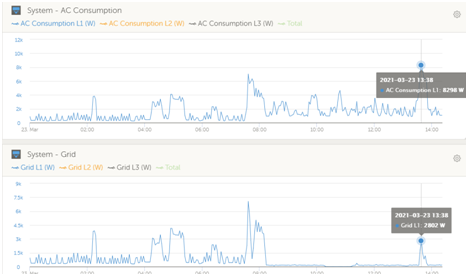Hi, Experts.
The picture shows the connection and functions. Will this work? Any HELP! Thanks

This site is now in read-only archive mode. Please move all discussion, and create a new account at the new Victron Community site.
Hi, Experts.
The picture shows the connection and functions. Will this work? Any HELP! Thanks

For power assist to work, you need to connect the loads to the output of the inverter. You can than set a maximum AC input limit.
This also works when using ESS, but the loads still need to be on the output.
And you can put a larger load. On than the output of the inverters assuming you don’t exceed the transfer contactor rating for the model you have.
You could use the AC 2 out on the Quattro to switch a contactor and disconnect your large loads when the input power goes out.
Thanks for the answer! I got a call from a Victron distributor from Moscow. Here is his answer: "Possible. Power Assist will work through its AC-IN. And for scheduled charging you need to use the Quattro Digital Input. Is there a reason not to trust the distributor?)
Why is the capacity of the grid changing? Is it solar?
The power assist function kicks in over a certain pre set amperage but there are ways around that depending on the reason.
Thanks for helping me! There will be no solar panels in this system. Only power peak compensation. I found the text in the instructions - https://www.victronenergy.com/media/pg/Energy_Storage_System/en/configuration.html#UUID-7435bdda-8f3f-81c2-a1a6-dc8f1c9b2f8f. Clause 4.2 (note) says the following -
Notes with regards to the Input current-limit and PowerAssist:
Input current-limiter setting - The configured limit is used as the threshold for AC current at the AC-in of the Multi / Quattro. Further notice that:
Loads in parallel with the Multi / Quattro are not taken into account: therefore, install all loads on the AC-out of the Multi or Quattro in systems that require AC Input Current limiter functionality. For example - systems with a small AC load connected.
The current limiter will be used for both directions of the current.
The PowerAssist setting in VEConfigure3 will be disabled and ignored when ESS is installed.
The Dynamic current limiter in VEConfigure3 will be disabled and ignored when ESS is installed.
If I understand correctly, the ESS assistant cancels the power assist function. I just need an ESS to charge batteries at a night time.
Perhaps I misunderstand this point? thank
Yes ESS when programmed unchecks the power assist function but it does have a power assist type of function and it does dynamically current limit.
Depending on how you set up your battery SOC and a few other settings your system will take most of the load anyway.
We are not allowed to feed back to grid but in our system this is the grid usage graph vs our ac consumption graph - note we only draw from grid when battery hits a certain SOC or the set inverter limit is reached and there is not solar available to assist loads.

We could probably trim the night use age down more but want to keep battery reserve in case of grid loss.
Thanks for the answer! In my case, the batteries are supposed to be used only if the limit of the input switch is exceeded. The load power is difficult to know. These are 10 residential buildings. Based on this, I wanted to connect the Quattro only via AC-IN. From the ESS assistant, I only need the function of charging batteries at night. If this can be done without ESS, I will be glad)
if the graph is power demanded then yes it’s how power assist works. Be sure your battery capacity is high enough to deal with the duration of the peaks
This is the power consumption graph. I wrote it conditionally. The load current can exceed the current of the inverters. Therefore, I only want to connect via AC IN. So that there is no overload. And the UPS function is not required.
If the Quattro is not able (in the presence of EM-24 or ET-340) to support the load at peak times together with the grid via AC-IN, then I see only one solution - to double the number of Quattro in order to avoid overloading the internal relay of the inverters. I'm right?
Additional resources still need to be added for this topic
35 People are following this question.